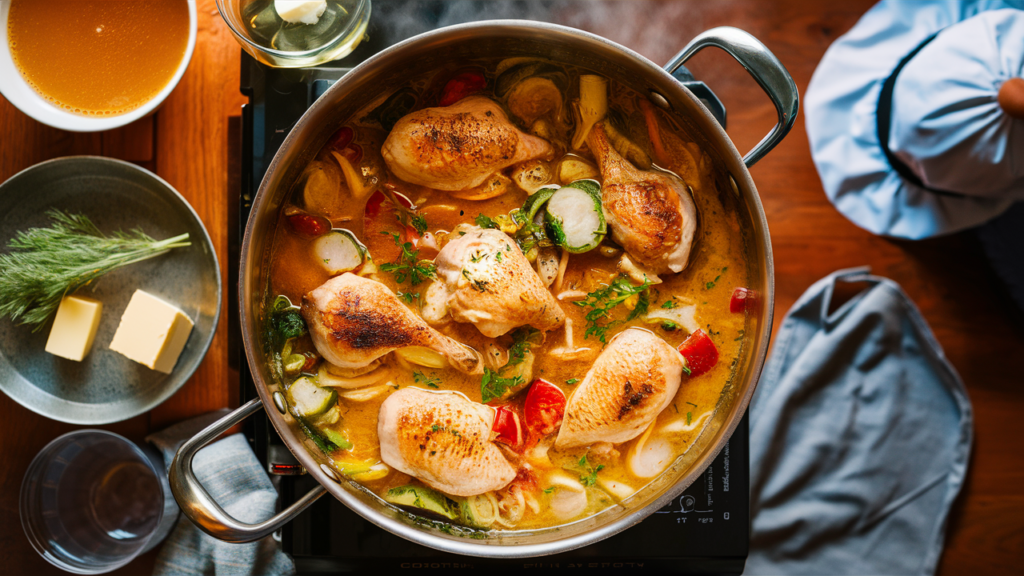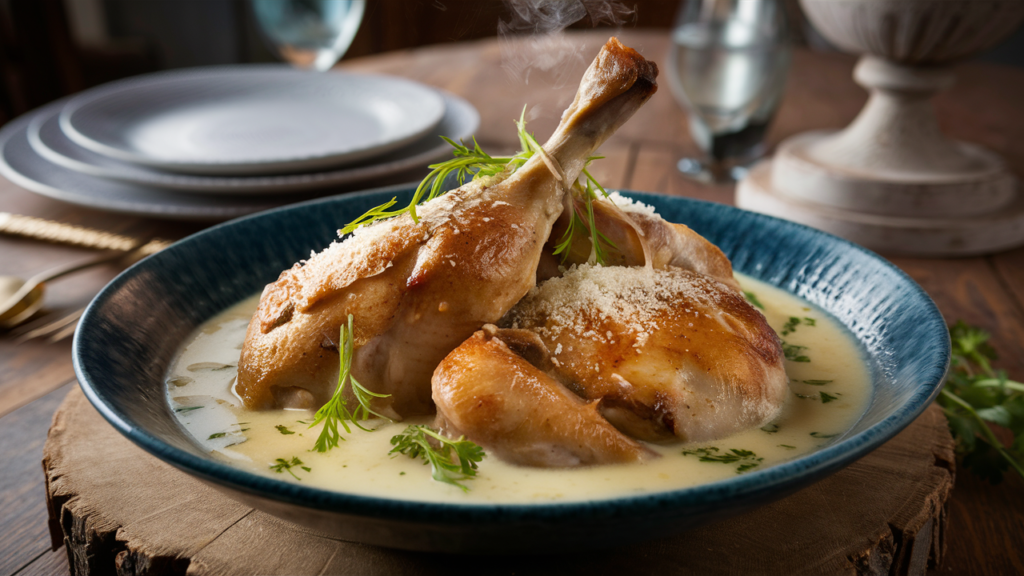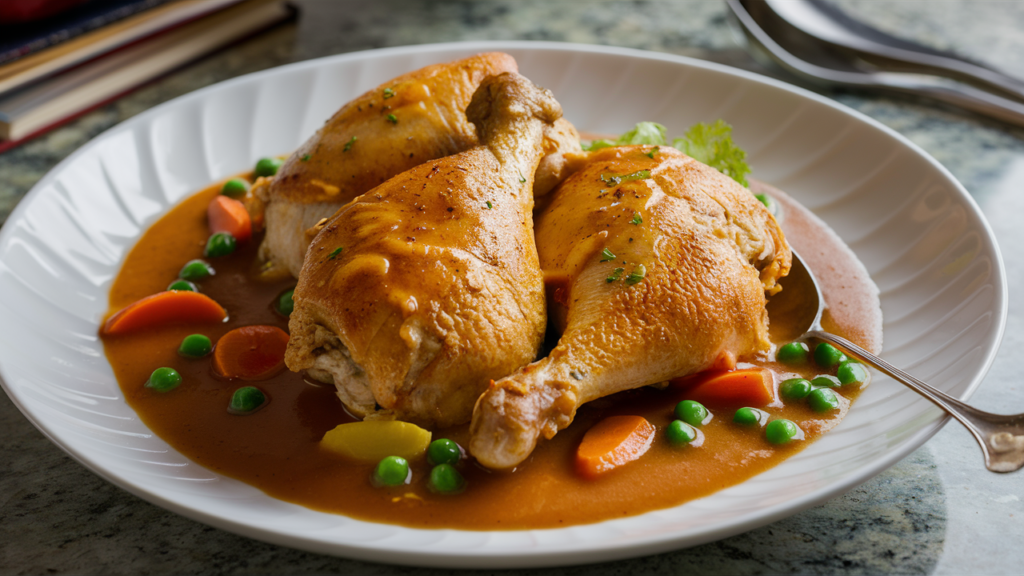Fricassee is a classic cooking method that has been cherished across various cuisines, particularly in French culinary traditions. This technique, while simple, imparts a deep flavor to both meat and vegetables, combining sautéing and stewing to create a dish that’s both flavorful and tender. In this comprehensive guide, we’ll explore the nuances of fricassee, including its definition, history, and how to prepare it using traditional and modern methods.
Understanding Fricassee
What is Fricassee?
Fricassee is not just any ordinary dish; it’s a specific type of stew, traditionally made with chicken, but adaptable to a wide range of meats and vegetables. The key characteristics that define a fricassee include:
- Meat: Typically, bone-in meat is used, which is first sautéed in butter until browned.
- Sauce: After sautéeing, the meat is cooked slowly in a stock, often thickened with a roux or by incorporating cream.
- Flavorings: Herbs and spices are integral, adding layers of complexity to the dish.
The hallmark of a fricassee lies in this two-step cooking process, where the meat is neither fully fried nor simply boiled, but rather sautéed and then simmered to perfection.
Historical Significance of Fricassee
Fricassee has a rich history that dates back to at least the 16th century in Europe. It was mentioned in various cookbooks throughout the centuries, evolving from a humble peasant dish to a refined culinary technique. Notably, fricassee was:
- Favored by royalty: Historical records suggest that fricassee was a popular dish among European aristocracy, particularly in France and England.
- Documented in literature: It has been featured in several classic cookbooks, including those by renowned chefs like Auguste Escoffier.
This historical journey highlights fricassee’s versatility and enduring popularity, showcasing its ability to adapt to the tastes and ingredients of various eras.
Variations of Fricassee
While the traditional fricassee is typically made with chicken, there are numerous variations that include:
- Different meats: Rabbit, lamb, and even seafood can be used.
- Vegetarian versions: Mushrooms or tofu can replace meat for a vegetarian or vegan fricassee.
- Regional twists: Different regions add local ingredients and spices, giving the basic fricassee a unique twist.
These variations ensure that fricassee remains a relevant and cherished dish in kitchens around the world.

Key Ingredients and Preparation
Selecting the Right Ingredients
The choice of ingredients in a fricassee can significantly affect its flavor and texture. Key considerations include:
- Meat quality: Opt for high-quality, bone-in pieces to enhance both flavor and texture.
- Freshness of vegetables: Use fresh herbs and vegetables for the best taste and nutritional value.
- Quality of stock: A homemade stock will provide a richer and more intricate flavor than store-bought options.
Selecting the right ingredients is crucial for achieving the authentic taste and texture that fricassee is known for.
Steps in Cooking Fricassee
The cooking process for fricassee involves several important steps:
- Sautéing the meat: This initial step involves browning the meat in butter, which seals in flavors and adds a rich texture.
- Preparing the roux: A mixture of flour and fat (often the same butter used for sautéing) is cooked to create a thickener for the sauce.
- Simmering: The meat is then slowly cooked in stock, allowing flavors to meld and deepen.
Each step is designed to build layers of flavor, ensuring a rich and satisfying dish.
Enhancing Flavor with Techniques and Spices
To elevate the flavor of a fricassee, consider:
- Herbs: Thyme, bay leaves, and parsley are classic choices.
- Spices: Nutmeg or white pepper can add subtle warmth without overpowering the main ingredients.
- Acidic components: A splash of wine or a squeeze of lemon juice can brighten the overall flavor profile.
Incorporating these elements thoughtfully can transform a simple fricassee into a gourmet experience.
Culinary Techniques and Tips
Mastering the Technique
Achieving the perfect fricassee requires mastering certain culinary techniques:
- Controlled sautéing: Avoid over-browning the meat, which can lead to bitterness.
- Roux consistency: Ensure the roux is smooth and free of lumps for a silky sauce.
- Slow simmering: Gentle cooking allows the meat to become tender without falling apart.
These techniques are essential for creating a dish that is both visually appealing and delicious.
Common Mistakes to Avoid
When preparing fricassee, it’s important to avoid common pitfalls:
- **Overco
oking the roux**: This can cause the sauce to taste burnt.
- Rushing the simmering process: Patience is key in allowing the flavors to develop fully.
- Overcrowding the pan: This can prevent the meat from browning properly.
By avoiding these mistakes, you can ensure that your fricassee turns out perfectly every time.
Advanced Variations for Experienced Cooks
For those looking to experiment, advanced variations of fricassee might include:
- Incorporating unusual meats: Such as duck or venison.
- Experimenting with exotic spices: Adding spices like saffron or cardamom can introduce new flavors.
- Using wine reductions: These can add depth and richness to the sauce.
Exploring these advanced techniques can help expand your culinary repertoire and impress your guests.

Pairing and Serving Suggestions
Ideal Side Dishes
To complement the rich and creamy texture of fricassee, consider pairing it with side dishes that can enhance its flavors without overwhelming the main course. Some ideal side dishes include:
- Buttered rice or pilaf: These provide a mild, comforting base that absorbs the sauce effectively.
- Steamed or roasted vegetables: Bright vegetables like green beans, carrots, or asparagus add color and balance to the meal.
- Crusty bread: Perfect for sopping up the delicious sauce, a loaf of fresh, crusty bread ensures not a drop goes to waste.
Selecting the right side dishes can transform a fricassee meal into a harmonious dining experience.
Wine and Beverage Pairings
Choosing the right wine or beverage to accompany a fricassee can elevate the dish significantly. Here are some recommended pairings:
- White wines: A crisp Chardonnay or a delicate Sauvignon Blanc pairs beautifully with chicken fricassee, enhancing its creamy texture.
- Light red wines: For a fricassee made with darker meats, consider a light Pinot Noir that can complement without overpowering the dish.
- Non-alcoholic options: Sparkling apple cider or a tart lemonade can also pair well, providing a refreshing contrast to the richness of the fricassee.
These beverage options cater to a variety of tastes and preferences, ensuring that everyone at your table can enjoy their meal to the fullest.
Serving Tips for Maximum Impact
Presentation is key when serving fricassee. Here are some tips to ensure your dish makes an impressive impact:
- Use warm plates: Serving on warm plates keeps the fricassee hot and inviting.
- Garnish wisely: A sprinkle of fresh parsley or chives can add a pop of color and a hint of freshness.
- Portion control: Serve moderate portions to appreciate the dish’s richness without becoming overwhelming.
Proper presentation enhances not only the look but also the taste of your fricassee, making it a memorable meal for your guests.
The Global Influence of Fricassee
Fricassee in Different Cultures
While fricassee is rooted in French cuisine, its influence can be seen in various dishes around the world. For instance:
- Caribbean Creole Fricassee: In the Caribbean, fricassee often includes tomatoes and a mix of local spices, reflecting the vibrant flavors of the region.
- Greek Fricassee with Greens: In Greece, fricassee is commonly prepared with lamb and an array of wild greens, drenched in an egg-lemon sauce to create a unique and tangy dish.
- American Southern Fricassee: In the Southern United States, fricassee might be served with a heavier, creamier sauce, often accompanied by biscuits or cornbread.
These international variations showcase how versatile fricassee can be, adapting to local tastes and ingredients while maintaining its distinctive preparation methods.

The Evolution of Fricassee
Over the years, fricassee has evolved, incorporating new ingredients and techniques while still staying true to its roots. Modern chefs might:
- Use sous-vide cooking: To ensure the meat is perfectly cooked before being finished in a sauce.
- Incorporate global ingredients: Such as coconut milk or curry spices, to innovate and fuse different culinary traditions.
- Focus on presentation: Modern plating techniques can make a traditional fricassee look contemporary and appealing.
This evolution reflects the dynamic nature of culinary arts, where tradition meets innovation, leading to exciting and delicious results.
Fricassee’s Role in Modern Gastronomy
In contemporary cuisine, fricassee serves as a bridge between classic and modern cooking techniques. It exemplifies how traditional methods can be preserved while still engaging with modern culinary trends. Additionally, fricassee:
- Teaches fundamental skills: Such as sautéing and making a roux, which are essential in many other dishes.
- Inspires creativity: Encouraging chefs to experiment with ingredients and flavors within a well-established framework.
The role of fricassee in modern gastronomy highlights its importance not only as a dish but as a culinary concept that continues to inspire and educate.
Conclusion
Fricassee is much more than just a cooking method; it’s a culinary tradition that spans centuries and cultures. By understanding its roots, learning how to prepare it properly, and exploring its global variations, cooks can appreciate the depth and versatility of this beloved dish. Whether served in a fine dining restaurant or a home kitchen, fricassee remains a testament to the rich history and continual evolution of cooking. Embrace this timeless technique and let it inspire your culinary journey.
You can get more recipes from here:

